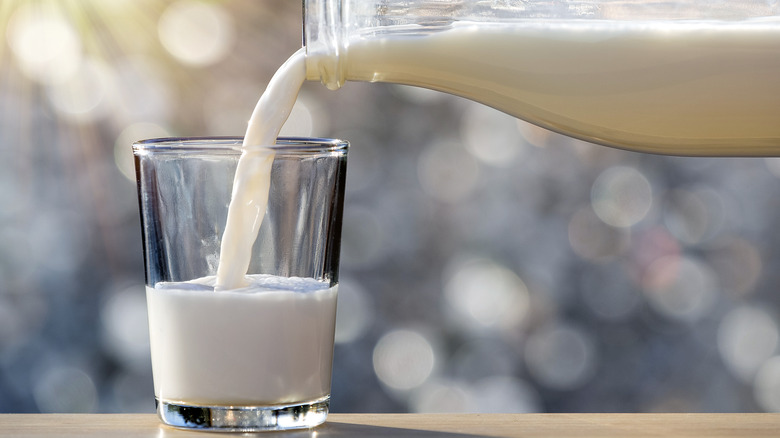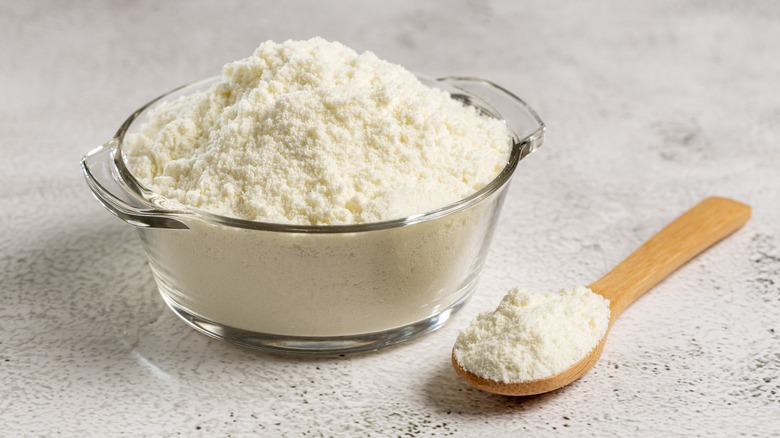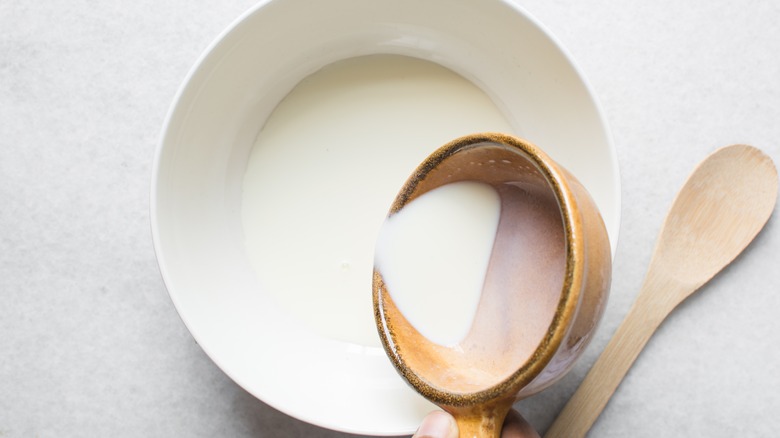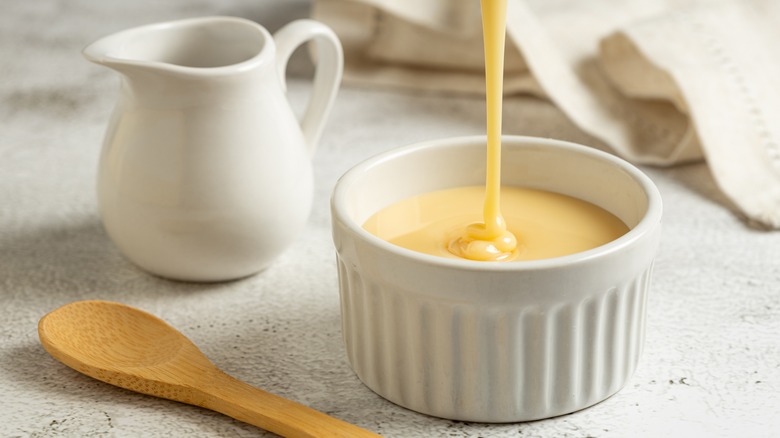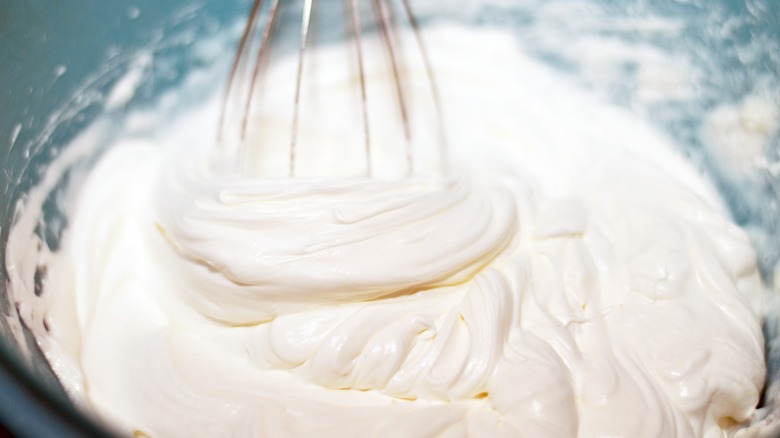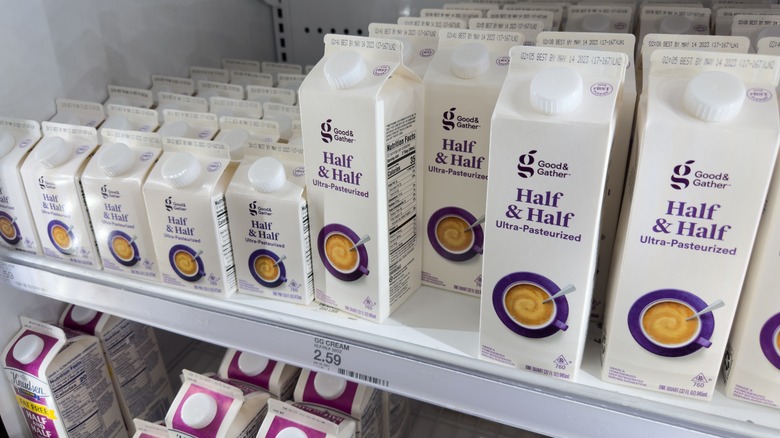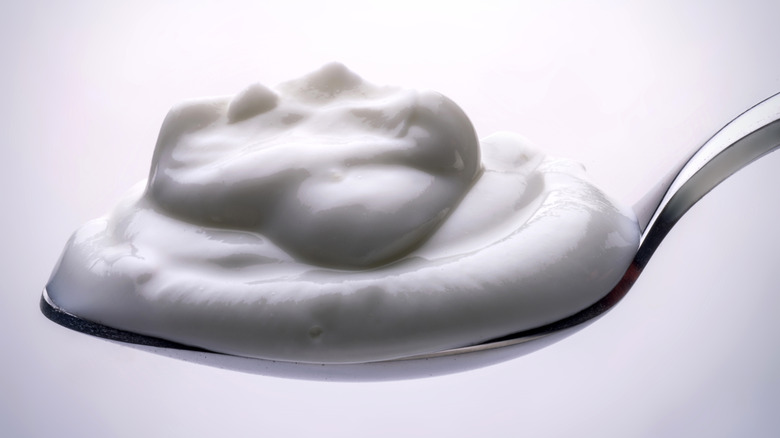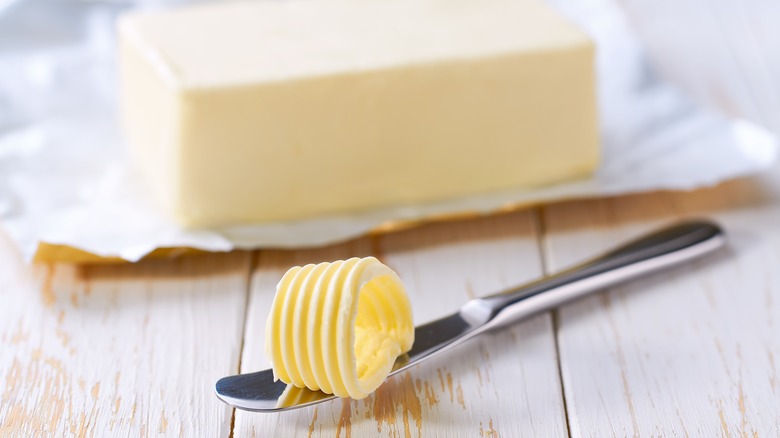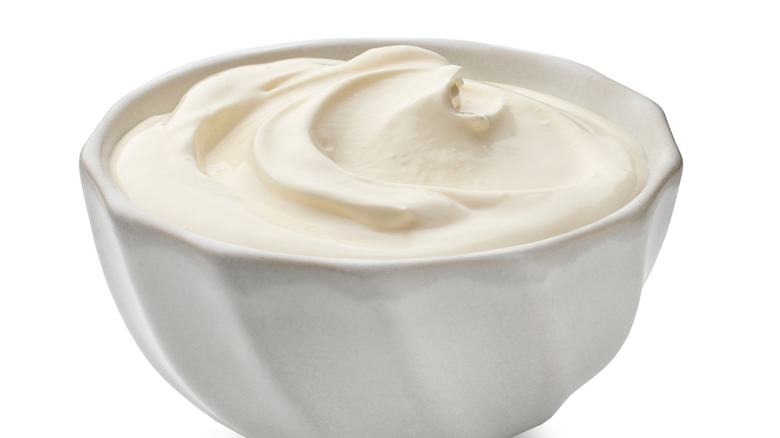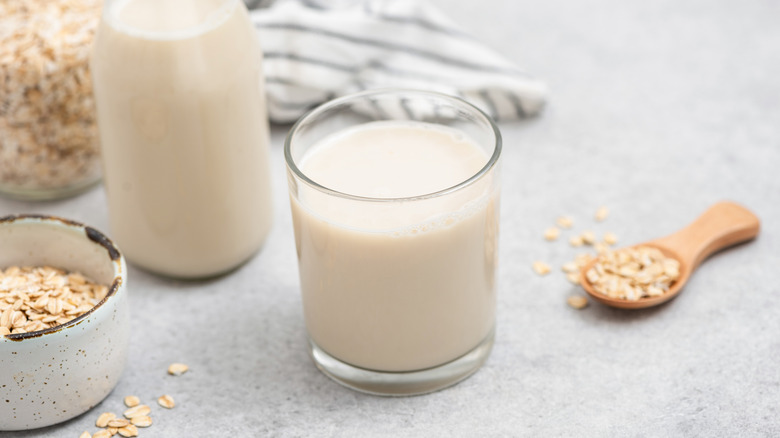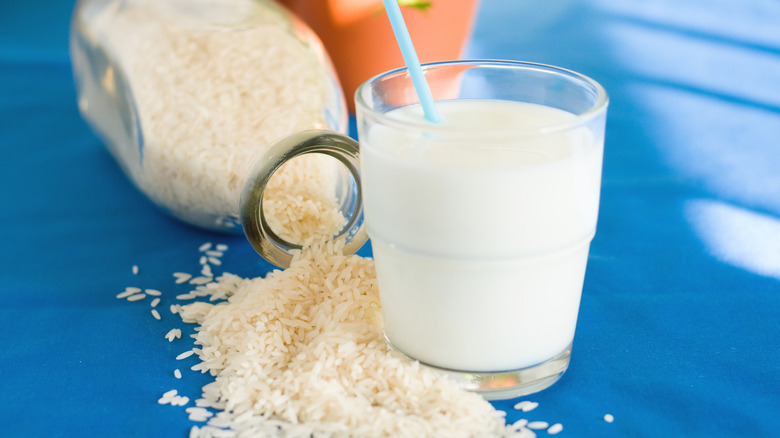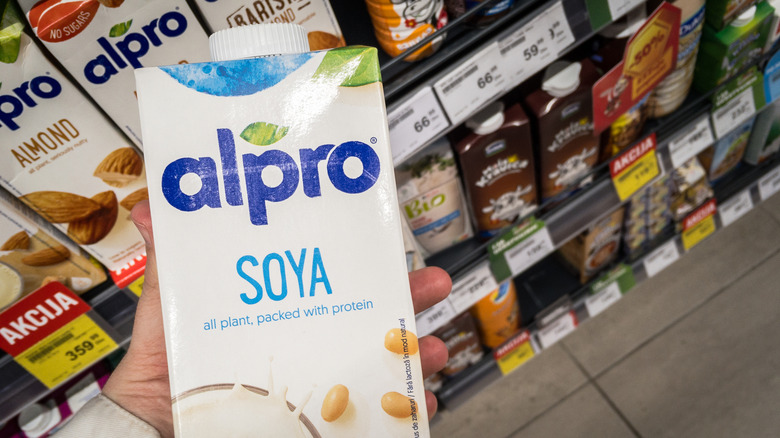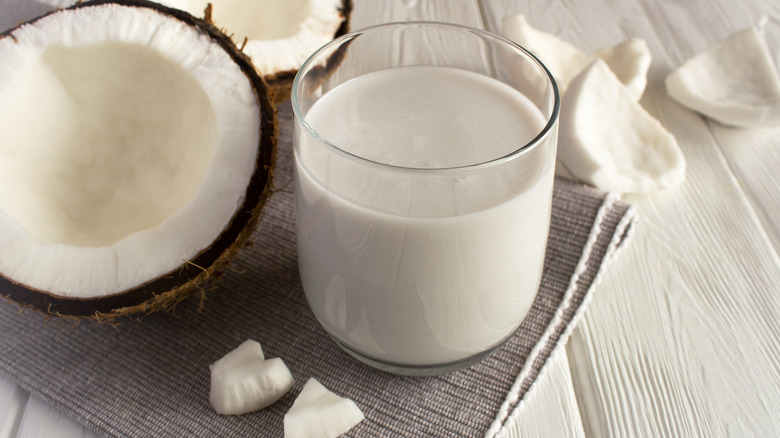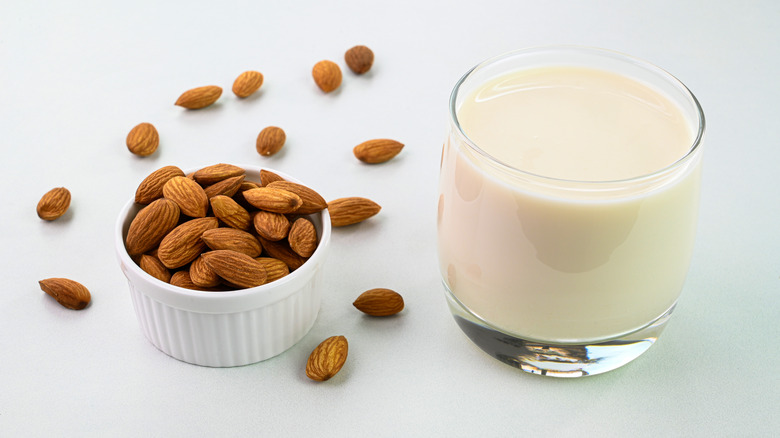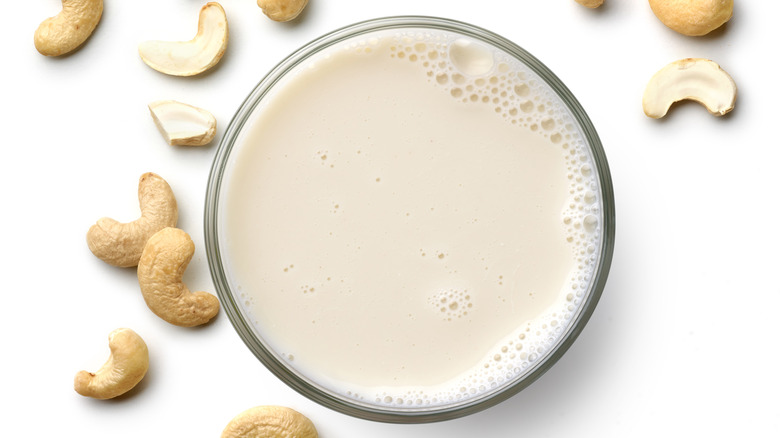14 Ingredients To Use Instead Of Milk
We pour it over our cereal, stir it into our coffee, and use it to make everything from savory dinners to decadent sweet treats. Milk crops up in just about every aspect of our kitchen endeavors, and since we get through so much of it, it's easy to run out of this ingredient. If the next time you reach for milk you find the carton empty, there's no need to worry. There are a wide range of alternatives that can stand in for classic cow's milk, and you may well have one of them on hand.
From plant-based drinks and powders to richer options like a humble block of butter, there are many ways to swap in other ingredients you already have in the kitchen. Perhaps you'd like to add a little extra creaminess to a recipe that typically calls for milk, or you want to switch up the flavor profile of a dish. If you're preparing a meal or drink for someone who follows a dairy or lactose-free diet, we have some great options in our selection too. So, let's take a look at 14 of our favorite simple milk swaps, and explore the unique benefits that each one brings to the table.
1. Powdered milk
Coming in a convenient, shelf-stable form, powdered milk is an excellent substitute for the fresh stuff. This handy powder is made by evaporating the liquid from milk until it becomes a dry powder. It's perfect for those who need a milk substitute with a lengthy shelf life due to its non-perishable nature.
To use powdered milk as a substitute, simply reconstitute it with water as per the instructions on the packet. This reconstituted milk can then be used in any way you'd use fresh milk, for everything from pancakes to sauces and soups. Alternatively, you can also add powdered milk straight into recipes in its dry form, which is particularly great for baking. This mighty powder can add an incredible richness to bakes, without introducing any excess liquid to the batter or dough. It makes a wonderful addition to cookies, helping to achieve that ultimate chewy yet crispy texture, or to bread, where it assists with leavening and makes the consistency extra tender.
There are plenty of other uses for powdered milk, too. This versatile staple can help with everything from whipping homemade ice cream and stabilizing whipped cream, to making mozzarella cheese or thickening mashed potatoes.
2. Evaporated milk
Fresh milk's creamier counterpart, evaporated milk, is made by removing about 60% of the water content from regular milk. The result is a thick, rich liquid with a more concentrated flavor that can enhance the taste and texture of many dishes. Evaporated milk typically comes in canned form, so it's a convenient ingredient to keep in your pantry.
This variation is often used in recipes where a creamy consistency is the goal. It can be added to soups, sauces, and dressings to provide a smooth, luscious texture. In baking, it works well in custards, pies, and puddings, bringing a deliciously rich depth of flavor. To use evaporated milk as a substitute for regular milk, mix it with an equal amount of water to achieve the consistency of fresh milk.
Since evaporated milk is a more concentrated version of your everyday fresh milk, it contains higher levels of nutrients and calories. In comparison to whole cow's milk, which contains 149 calories per cup, the same quantity of whole evaporated milk packs 338 calories. Evaporated milk is also incredibly rich in minerals such as magnesium, zinc, calcium, and phosporus, and many brands fortify it with vitamins D and A, too. So while it might not be an ideal choice if you're on a calorie-controlled diet, it certainly comes with plenty of health benefits.
3. Condensed milk
Though often mistaken for evaporated milk, condensed milk has very different properties. These two types of milk are both made by removing most of the water content from cow's milk. But, unlike evaporated milk, condensed milk is heavily sweetened, with about 45% of its make-up being sugar. This gives it a very thick consistency, serving as an indulgently rich and creamy addition to your recipes.
Condensed milk is most commonly used in desserts, such as pies, ice creams, and puddings. It can also be used to make an easy homemade fudge recipe when melted together with chocolate chips and cooled until set. Or, try using it to sweeten beverages like coffee and tea, or pour it over a poke cake for a decadent finish. For baking purposes, it acts as both a sweetener and a thickener, so using it in place of milk will result in a slightly different texture.
As with evaporated milk, you will need to dilute condensed milk with water to use it in place of regular milk. You may also need to account for the extra sweetness by reducing the sugar in your recipe. For savory dishes, it's best to choose another milk substitute unless you feel the sweetness would complement the dish.
4. Heavy cream
As the name would suggest, using heavy cream in place of milk is likely to result in a richer and more luxurious result. Heavy cream has a fat content of around 38%, which definitely trumps the comparably measly 3.25% found in whole milk. This richness makes it a great choice for recipes that benefit from a thicker consistency and a more indulgent flavor.
Since it's unsweetened, heavy cream is perfect for elevating both sweet and savory dishes. For the ultimate velvety texture, use it to make creamy soups, pasta sauces, or a quiche filling. For baking, heavy cream is of course a key component in any cake or pudding that requires fluffy whipped cream, and it's also crucial for making chocolate ganache and no-bake cheesecake. If you're out of milk and want to use heavy cream to mimic its consistency, you can also dilute the cream with water, using a ratio of one part cream to one part water.
5. Half and half
Half and half is another popular dairy product that consists of equal parts whole milk and heavy cream. With a fat content ranging from 10% to 18%, it offers a balance between the richness of heavy cream and the lightness of milk. Half and half is a versatile ingredient in the kitchen, lending itself well to a whole host of recipes.
The best time to use half and half is when you're aiming to achieve a creamier texture than milk can provide, but don't quite need the full richness of heavy cream. It works fantastically in coffee or hot chocolate, delivering a creamy mouthfeel without being overly heavy. It's also ideal for making silky sauces and gravies, since it doesn't curdle under high heat like milk.
If you're looking to thicken the texture of a dish, heavy cream will do a better job here due to its greater fat content. Or, to convert half and half into a liquid with more of a milk-like consistency, combine one part half and half with one part water.
6. Yogurt
Yogurt is another ingredient that many people already have in their fridges, and it can certainly serve as a substitute for milk in many circumstances. In fact, this thicker, tangier dairy product actually starts out at milk, which then undergoes fermentation by live bacterial cultures. The probiotic nature of live yogurt makes it excellent for supporting gut health, and it often comes in low-fat or fat-free versions too.
Yogurt is a popular addition to many baking recipes, such as muffins, cakes, and quick breads, where you can use it as a milk replacement following a one-to-one ratio. It works brilliantly to provide moisture and a slight tangy taste. In savory dishes, yogurt is particularly delicious added to dressings and marinades, offering a creamy consistency and enhancing the flavor with its unique richness. Or, try stirring a dollop of Greek yogurt into a spicy curry or coconut red lentil dal before serving to balance out the heat.
If you're planning to warm up yogurt, be aware that it does have a tendency to curdle. However, you can prevent this by stabilizing it first. Simply mix corn starch and water until you have a slurry, then whisk it into the yogurt on the stovetop over low heat.
7. Water and butter
Out of milk but you have plenty of butter in the fridge? Well, you're in luck, because creating an effective milk substitute can be easily accomplished by combining butter and water. This simple mixture mimics the fat content and moisture that milk provides, making it suitable for many baking and cooking applications. To create a milk substitute with water and butter, melt 1 tablespoon of butter and mix it with a cup of water.
This mixture can be used in baked goods like cakes, muffins, and pancakes, where milk is often a key ingredient. You'll find the fat from the butter compensates for the lack of creaminess in the water. You can use this substitute in savory recipes as well to add richness without significantly altering the flavor profile. Butter is also much lower in lactose than milk, so this is a great substitution if you're lactose intolerant. Keep in mind that the butter and water method might not work quite as well in recipes where you want the distinct flavor of milk to shine through, such as in custards or puddings.
8. Sour cream
Sour cream isn't just for dolloping onto tacos, it's also a valuable ingredient in a variety of recipes. This tangy dairy product is made by fermenting regular cream with lactic acid-producing bacteria, resulting in its characteristic thickened texture and slightly sour flavor.
Ideal for baking, sour cream can be used in place of milk in a one-to-one ratio. The acidity of sour cream works to activate baking soda, which helps to leaven muffins and quick breads, giving them a fluffy, tender texture. The sour cream also adds moisture and richness to your baked goods without making the batter too runny, for a deliciously soft and flavorful result. Due to its acidic properties, it makes an excellent replacement for buttermilk.
Sour cream is also a popular component of savory dips, adding a wonderful tangy dimension that seamlessly complements a range of other flavors. Or, try adding it to mashed potatoes or potato salad for a satisfying creamy texture.
9. Oat milk
There's a plethora of different options in the world of plant-based milks, all aiming to serve us in a similar way to cow's milk. It can be a little overwhelming deciding which option is best suited to your needs, but if you're looking to replicate the creamy texture and mild, slightly sweet taste of milk, oat milk is an excellent choice. Made simply from oats and water, this dairy-free option is great for anyone with dietary restrictions or those who simply prefer to exclude dairy.
It works well in place of cow's milk for hot drinks due to its ability to froth, and can also be added to smoothies or poured over cereal. Simply switch it in using a one-to-one ratio. Incorporating oat milk into your cooking and baking is no problem, either. Try using it to whip up waffles or pancakes, or combine it with olive oil, flour, garlic, nutritional yeast, and lemon juice to make a vegan-friendly Alfredo sauce.
10. Rice milk
Next up in the non-dairy realm, we have rice milk. This alternative milk is made by soaking and grinding down rice grains before blending them with water then straining off the solids. It's known for its thinner texture and naturally sweet flavor, and many consumers claim it's the closest alternative to the flavor of cow's milk. Rice milk is also naturally lactose- and dairy-free, as well as containing none of the major allergens. Therefore, it's a great choice for anyone with an allergy to nuts or soy, which are common ingredients in other plant-based milks.
Rice milk can be used as a substitute for milk in many ways. Use it in your oatmeal or overnight oats for a lighter result, to make a healthy dressing, or even for a vegan cauliflower cheese recipe. Due to its thinner texture, rice milk isn't quite as ideal for making creamy sauces. If you're planning to whip up a dairy-free béchamel, try opting for oat or soy milk instead.
11. Soy milk
Soy milk, also known as soya milk, is one of the most widely used plant-based milk alternatives due to its creamy texture and neutral flavor. It's an incredibly valuable staple for those who follow a vegan or dairy-free diet, being super versatile and providing plenty of nutritional benefits too. You'll have no problem using soy milk as a direct substitute for cow's milk in most dishes. Its mild taste means it won't have a drastic impact on the flavor of your bakes, meals, or beverages. It's enjoyable to drink as is, perhaps accompanied by a tasty vegan cookie.
Soy milk is rich in protein, providing a nutritional profile similar to cow's milk. It is also low in saturated fat and cholesterol-free, making it a heart-healthy choice. Many commercial soy milk products are fortified with vitamins and minerals, such as calcium and vitamin B12, which are all essential nutrients found in dairy milk. Additionally, it contains compounds called isoflavones, which have been linked to various health benefits, including improved heart health and reduced menopausal symptoms.
12. Coconut milk
If you love the tropical taste of coconut, this alternative milk is the perfect one to try. Coconut milk can provide a wonderfully luscious texture, with applications spanning a host of sweet and savory recipes. It is made with grated coconut flesh, which is then combined with water and sometimes additional stabilizers to maintain a creamy texture. It's available either in canned or cartoned form, and each will give you different results in your recipes. Canned coconut milk is much richer and thicker, while the version in a carton typically contains more water and a lower concentration of coconut. The latter is more close in consistency to regular milk.
Canned coconut milk is commonly used in savory recipes, such as curries or soups, with its distinct taste adding a unique depth of flavor to the dish. It's also widely used in vegan baking, such as in pies, ice cream, or even lemon bars. On the other hand, a carton of coconut milk is best used where you'd typically opt for milk. Add it to drinks, smoothies, cereal, or any recipe that calls for standard cow's milk.
13. Almond milk
Another extremely popular milk alternative, almond milk has a mildly nutty flavor and light consistency. It's featured in countless plant-based recipes and stocked in coffee shops across the world. Almond milk often comes in two main categories — sweetened and unsweetened, as well as a few flavors, so you can select the option that best suits your needs.
To make almond milk, the nuts are first soaked in water until they soften up, before being ground into a paste. This paste is then filtered and combined with water. You can even make your own almond milk at home using a high-powered blender and a nut milk bag.
Simply use almond milk as you would regular milk. Trying adding it to baked goods, whether that's vegan baked donuts or cinnamon buns, or to savory dishes like lasagna or a cheese sauce. You'll also get the added benefits of the nutrients it contains, which include magnesium, vitamin E, and calcium. Plus, the unsweetened variety has a low glycemic index (GI), which means it won't cause any drastic spikes in your blood sugar like oat and rice milk.
14. Cashew milk
Despite perhaps being less common, cashew milk certainly rivals the more popular soy and oat milks in terms of its creaminess and versatility. This milk can fit into recipes just as seamlessly as other plant-based alternatives, bringing a slight nutty taste and plenty of goodness.
There are so many ways to use this delicious milk substitute. Try making refreshing popsicles by combining cashew milk with fresh blueberries, vanilla extract, and a little sugar, before pouring the liquid into popsicle molds and freezing. Or, make a wholesome breakfast chia pudding, with the milk and seeds as the base, and add your favorite fresh fruits. You could also add a splash to a garlicky red pepper pasta sauce to give it a wonderful silky texture.
As well as being dairy-free and vegan, cashew milk is also a great source of healthy fats, minerals, and vitamins. This is particularly true in the case of homemade cashew milk, which tends to contain a greater percentage of cashews than store-bought varieties. A cup of homemade cashew milk typically contains 20% of your recommended daily intake of magnesium. For iron, the value sits at 10%, and for potassium it's 5%. To make your own cashew milk, you'll first need to soak the nuts in water overnight. Then, simply blitz everything up in a blender (no straining required) and store it in the fridge.
